If you are heading to Barcelona, Sagrada Familia is an essential attraction you can't miss. Approximately 4 million people visit this iconic basilica every year, and on any given day, queuing up for a ticket to enter this UNESCO World Heritage Site may take hours. It’s especially frustrating during peak season when you see a huge line just to get in. While you can stay inside as long as you want, entry is managed in batches, making ticket timing crucial.
Make sure you buy the right ticket and know all your options to skip the line. Read on to discover various ways to bypass the queue.
How long is the wait time at Sagrada Familia
Peak Tourist Season: Between June and August, wait times at the ticket office can stretch from 1 to 2 hours due to the sheer number of visitors. Over 3 million people flock to the basilica annually, with the bulk arriving during these months.
Off-Peak Times: During the calmer seasons, waits can be shorter, typically around 30 minutes to an hour on busy days. However, buying tickets on-site can still mean longer queues during peak hours. Be aware that entry isn't guaranteed if the site reaches full capacity, especially for larger groups.
6 ways to skip the lines at Sagrada Familia
1. Buy fast-track tickets with hosted entry
You can purchase your fast-track Sagrada Familia tickets online well before your trip to Barcelona. An English-speaking guide will greet you and provide a 30-minute introduction about the history and significance of this UNESCO-listed basilica as you marvel at its grandeur. Once you confirm your booking with the chosen date and time, you’ll receive an e-ticket. Simply display this upon arrival to enjoy priority access.
2. Book a Sagrada Familia Guided tour
One of the best ways to explore any place, specially a historical monument like the Sagrada Familia, is to go with a trained guide. In this case, opting for this option not only opens up a mine of information, but also gives you priority access to the structure. Depending upon what you prefer, you can choose between three tour options: Self-guided tour, Tour with an audio-guide, or Sagrada familia guided tour with a trained official guide.
3. Go early
La Sagrada Familia opens at 9am everyday and this is when the crowd is at its least. It's not absent, since many people do get there before the gates have opened. However, you do get to enjoy the basilica with a comparatively lesser crowd around.
4. Visit on a Monday
While most museums in Barcelona are closed on Mondays, visitors often think the Sagrada Familia is, too. However, it is open every day, including Christmas and New Year's. Since most tourists assume it's closed on Mondays, it is slightly less packed and makes for the perfect day to visit sans crowds.
5. Buy tickets for the Nativity Facade
Consider this Plan Z. The Nativity Façade tower has a separate entrance from the main entrance. One needs to walk down steep stairs to reach this part of the Basilica - the reason most people choose not to visit this part of the Basilica. There is a special ticket to access this section that costs around €29 which guarantees a 15-minute window to enter and incredible views over Eastern Barcelona.
6. Grab the Park Guell + Sagrada Familia Combo deal
Move past the long ticket lines and head to these iconic Catalan landmarks without wasting time standing in the lines. On this guided tour, you will be visiting two of his most beautiful, and equally eccentric, contributions to Catalan Modernisme - the Sagrada Familia and Park Guell. The tour is 3.5 hours long and will help you not only see the most beautiful landmarks of Barcelona but also learn what it was that drove this movement and its significance to the Catalan region.
7. Buy the Barcelona City Card
If individual Sagrada Familia tickets are sold out, consider getting the Barcelona City Card, which grants access to over 25 attractions and includes public transport. A visit to Sagrada Familia is included, with dedicated slots for cardholders, giving you an alternative route to ensure your entry even when standard tickets are unavailable.
Sagrada Familia Skip The Line Tickets vs Guided Tours - What to choose?
There's so much to learn from every nook and corner of Sagrada Familia, the only way to do justice to your visit is signing up for a guided tour. Exploring the facades, the towers, the luminous stained glass windows and the interiors with a knowledgable local guide is the best way to experience all that this Basilica is.
The best part a guided tour however, is the Skip The Line access you enjoy. Meet your guide outside the Basilica and enjoy fast track access without having to wait in queues.
However, if you're on a budget trip to Barcelona, a Skip The Line ticket does the trick. For a small premium, you get to save a lot of time and energy. You can also grab an audio guide to explore Sagrada Familia at your own pace or simply read our comprehensive Sagrada Familia guide before you go!
Related Read:The advantages of Sagrada Familia Guided Tours
Inside Sagrada Familia - What To Expect?
The Nativity Facade

The foundation for the Nativity façade was laid in 1892. It was Gaudi’s decision to first build this part of the Church. In his words, “If, instead of building this decorated, richly ornamented facade, we had started with the hard, bare and skeletal Passion facade, people would have rejected it.”
If you are an architecture fanatic or just a curious traveller, witnessing the beauty of this part of the Church will transport you back in history. Don’t miss the Rosary portal which is part of this façade, and is one of the entrances to the Basilica. The first of the four bell towers on this side of the structure was dedicated to Saint Barnabus, and is 100 meters tall. Its construction was finished on 30th November, 1925. For any Gaudi fan, this is an important piece of architecture as this was the only tower he saw getting completed before he died. The mosaics that spell out ‘Sanctus, Sanctus, Sanctus, Hosanna in Excelsis, Amen, Alleluia’, decorate the tops of these towers. Just remember to look up when you are there.
The Passion Facade

The Passion facade is strikingly different in form when compared to the Nativity Facade. Contrasting the smooth classical curves of the statues on the Nativity Facade are bare stone statues on the Passion Facade that have been carved with straight lines - representing the passion and suffering of Jesus Christ. The statues on this facade have been made to resemble the bones of a skeleton and also hint at the sins of man.
The Passion Façade faces west and and is symbolic of the death of Jesus. Supported by six large columns, the pyramidal pediment of the facade culminates into a large cross with a crown of thorns. The Passion Façade also has four spires, dedicate to apostles James, Philip, Thomas and Judas. The building of Passion façade started back in 1954, and later, a crypt was built here inside which a Museum was set up in 1961. It provides a wealth of information about the history of the temple, and contains details about its artistic, symbolic and technical aspects.
The Towers
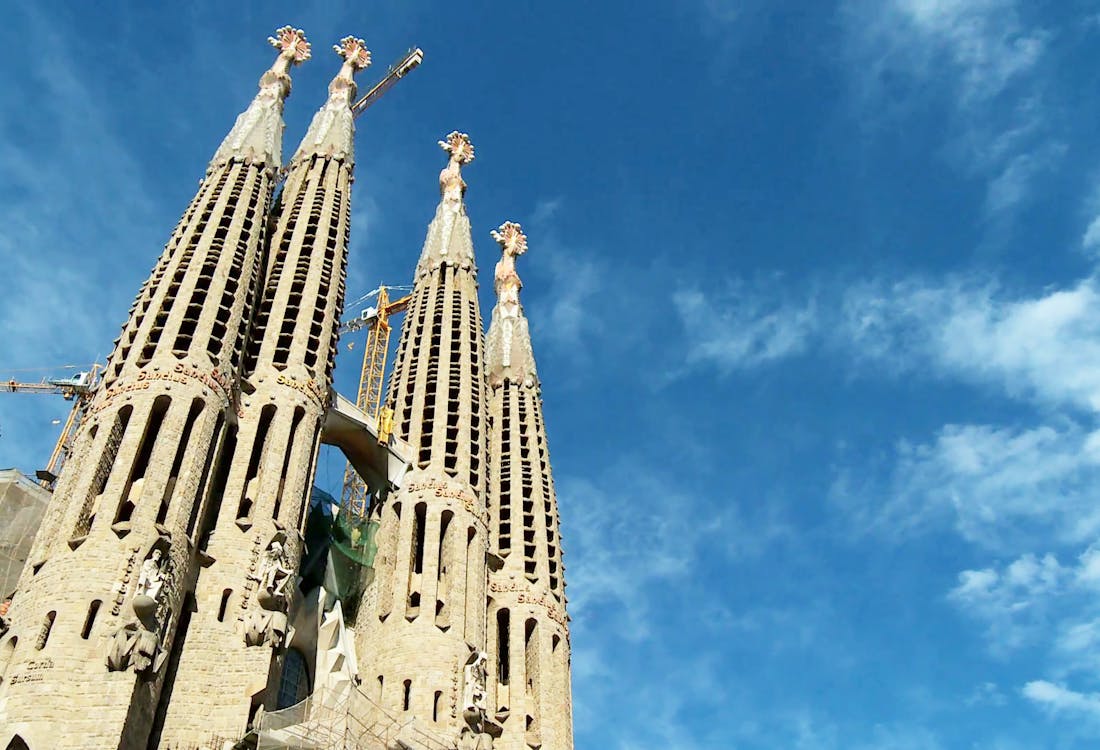
The towers of the Sagrada Familia Basilica are a formidable sight. Of the 18 towers that Gaudi envisioned, 8 have been completed - 4 towers on the Nativity Facade and 4 towers on the Passion Facade. You can access these towers if you have a ticket with tower admission enabled. The towers on the Nativity Facade look over the east of Barcelona while the towers of the Passion Facade face the city centre. You can use an elevator to go up the tower, however, one must take the stairs down from the towers.
Related Read: Are the Sagrada Familia Towers Worth It?
Sagrada Familia Interior
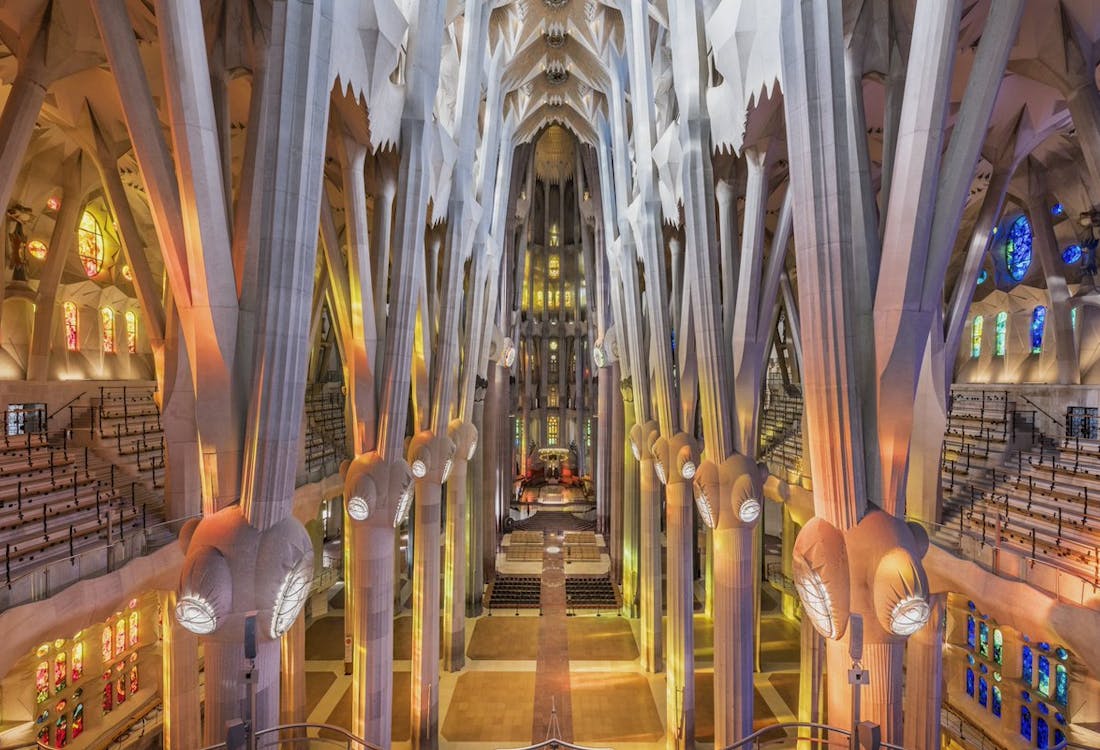
The floorplan of the Sagrada Familia is that of a Latin cross with five aisles. The central nave is significantly higher than the 4 side naves. The central nave vaults are 150 feet tall while the side nave vaults are 100 feet in height. The original plan was similar to that of a Gothic church but the need for external support and flying buttresses pushed Gaudí into coming up with an ingenious structure using pillars and columns that branch out like trees into the vault.
The materials used to make these columns vary. The longest and thickest columns are made of red porphyry, a very hard volcanic rock. Basalt and granite has been used to make the dark, somewhat smaller pillars while the outermost row of pillars in the church use a relatively soft rock from Montjuic, the mountain of Barcelona.
Apse
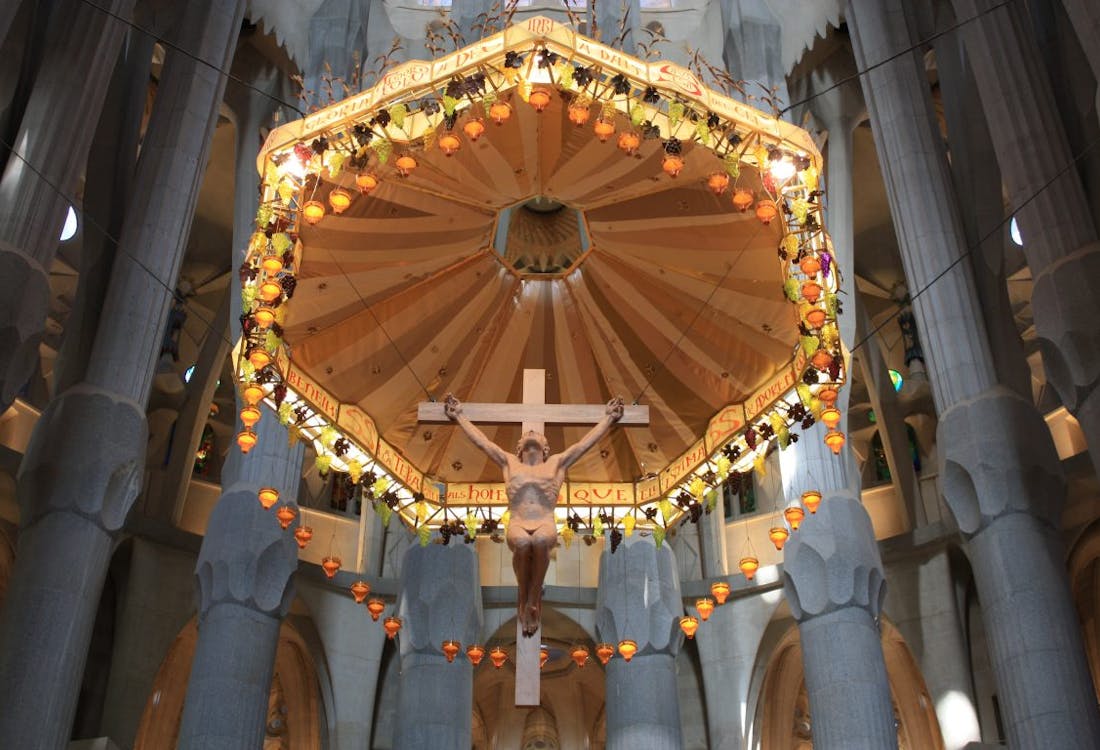
In architecture, one half of a dome roofed area is called an Apse. In a church, the Apse is usually the structure that houses the altar. The Sagrada Familia’s Apse was built by Gaudí in 1894, immediately after the construction of the crypt was completed. The open structure of the apse, with its beautiful windows, floods the apse with light during the day. The raised altar lies in the center of the apse and is crowned by the Latin cross with a canopy decorated with grapevines. The organ pipes are placed behind the altar.
The inside walls of the apse are decorated with angels’ heads and tears. The apse is surrounded by seven chapels and has side stairs to its left and right. These stairs lead to spiral staircases from the crypt and continue up into their respective façades. Two big stone snails crawling down the walls of the apse act as an indication for this spiral staircase.
Stained Glass Windows
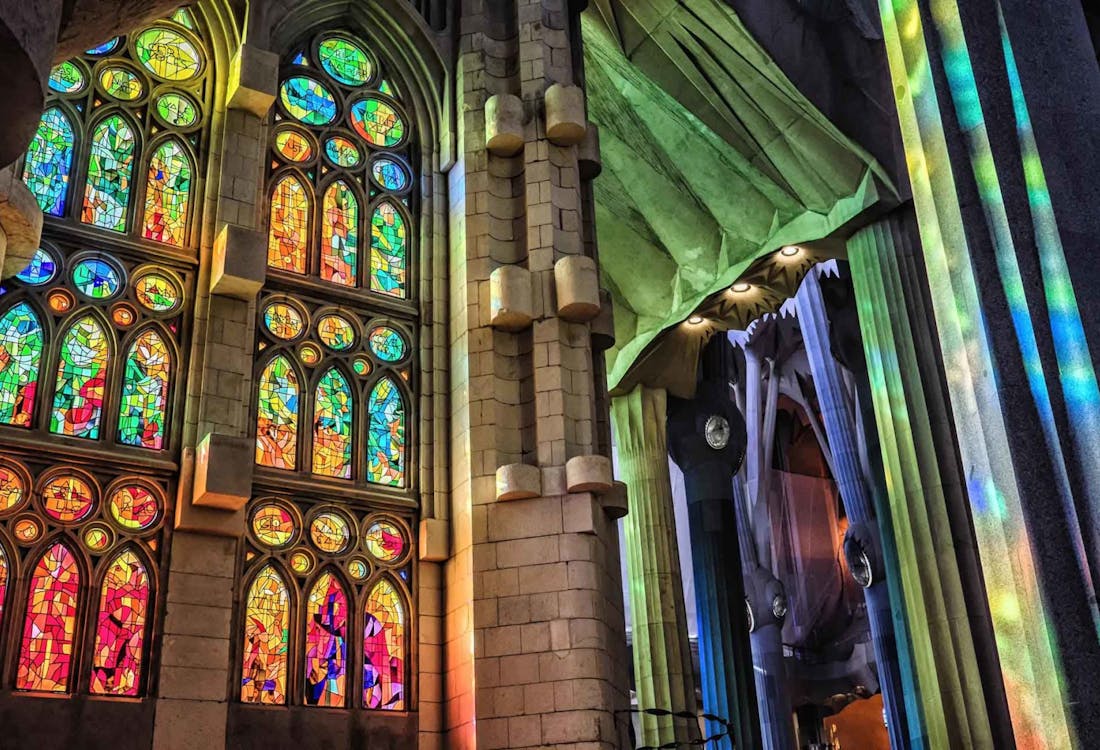
Gaudi's love for colour is well-known and the no other work of his showcases this more than the beautiful and vibrant stained glass windows of the Sagrada Familia - painting the interiors with beautiful hues of red, green, blue and yellow. In order to achieve a harmony of colour and light, the windows have been arranged in a particular manner. The windows of the lower part are brightly coloured while those on the upper half are almost translucent, thus lighting up the interior and making the vaulted ceilings stand out.
Cloister of Dolours and Sacristy

The Cloister of Our Lady of Dolours is connected to the sacristy on the west side of the Sagrada Familia. The “Way of the Liturgy”, an exhibition of pieces Antoni Gaudí designed for the Catholic liturgy, is located in the cloister. The exhibition includes wrought iron candlestick, a cross with candles and a lectern three sacral.
The sacristy to which the cloister connects is a bright, open space where priests get ready before mass. The sacristy has two closets – one to store the liturgical vestments worn by the priests and another to store liturgical objects such as chalices and patens. Each part of the cloister and the sacristy has been designed by Antoni Gaudí himself.
Crypt of the Expiatory Temple
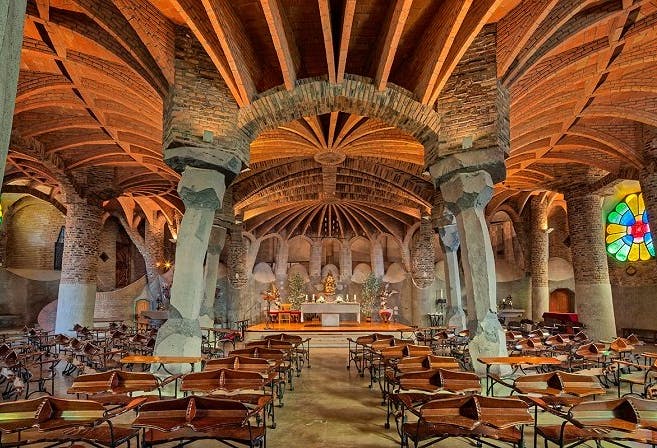
The Crypt at Sagrada Familia is the oldest part of the Church and is said to have been under works even before Gaudi was commissioned to design and build the rest of Sagrada Familia. Unlike the rest of Sagrada Familia, the Crypt is constructed in Neo-Renaissance style with mosaic floors depicting luscious vines, columns that are richly decorated with roots, leaves and branches; all of which served as a precursor to the fantastic concepts that were to become Gaudi's intrepid designs. Antoni Gaudi is buried in the Crypt ( to the left of the main altar) and there are frequent masses held in Crypt.
Museum
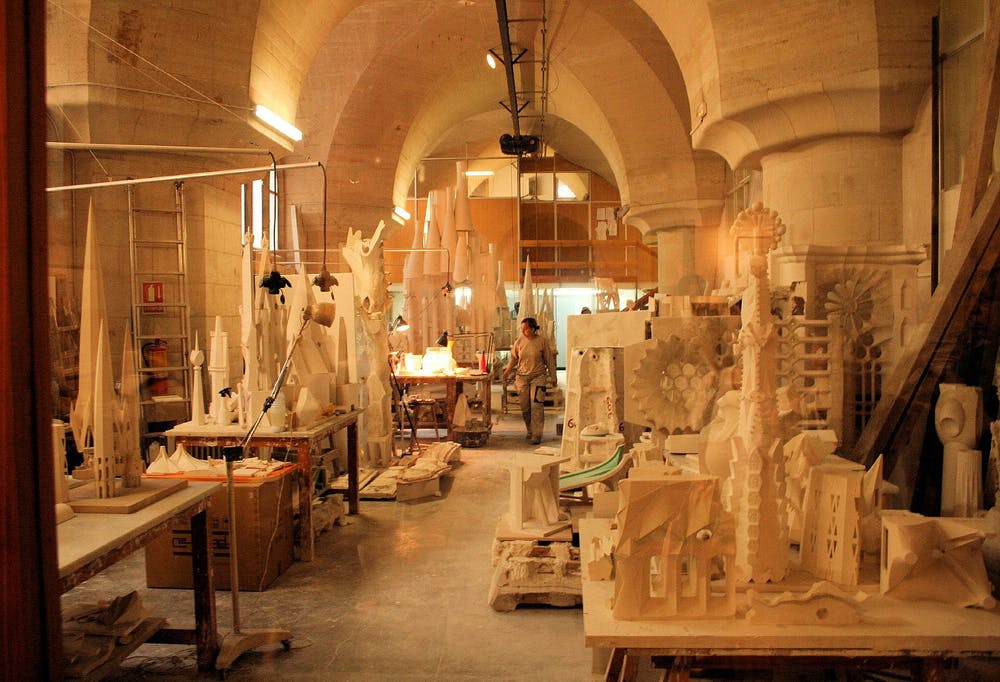
The Sagrada Familia Museum is an underground exhibition that houses Gaudi’s construction models, drawings, contemporary photographs and liturgical furnishings. In the fire of 1936, many of Gaudi’s designs and plaster models were destroyed. After a painstaking process of collecting the destroyed models and restoring them, the Sagrada Familia Museum was opened in the semi-basement under the Passion façade.
Today, visitors can look at these models to get an understanding of the scale of the construction that Gaudi initiated. The complexity of it all is not lost when one goes through his models and drawings. The exhibitions are part of the new “Inspired by nature” section and feature a 102-m² space with large-format photos and 20 plaster models. The museum aims at helping visitors understand the role nature played in Gaudi’s designs.
Rules and Regulations
- As visitors, your bags, luggage, and other personal belongings will be screened at the entrance.
- If you are planning to go on top of either of the towers, keep in mind that children who are less than 6 years of age are not allowed to go up. Also, children who are less than 16 years old can go up provided they are accompanied by an adult.
- You should have your ticket at all times while you are in the Basilica’s premises.
- It is advised that you refrain from creating crowds or running in the premises.
- You can’t eat, drink or smoke on the site.
- You can't use tripods or professional camera equipment on the premises without prior permission.
- If you are opting for a tour with an audio guide, please return the audio guides and transmitters/receivers in the condition you received them.
- Being a religious monument, it is important to dress appropriately and keep in mind the following:
- Avoid clothing that may be see-through, and wear something that keeps your shoulders covered.
- Refrain from wearing clothes with plunging necklines, or show bellies or backs.
- If you are wearing shorts or skirts, make sure they reach mid-thigh.
Sagrada Familia skip the line ticket reviews
A convenient and quick way to book ahead. Easy app to use even for a senior like me also good customer service with lots of information available.
- Josephine, Headout, February 2020
This is a very efficient and serious ticket company. Straight after booking I received a Whatsapp message and email with all the details. They sent instructions of exactly where to meet at picture of the outside of the gift shop. Our tour guide was also lovely. She was funny and very knowledgeable. I would book again if I came back to Barcelona. If you go to Segrada Familia definitely get the skip the line ticket and guided tour.
- Madeleine, Headout, August 2024


